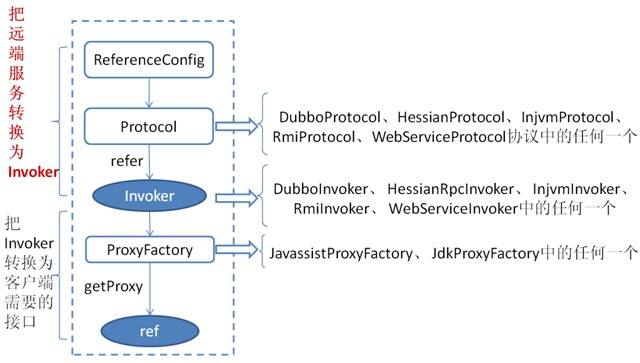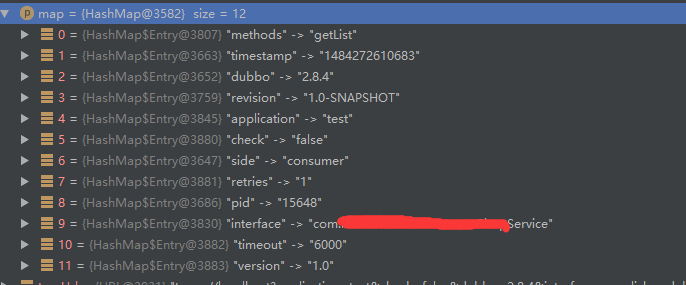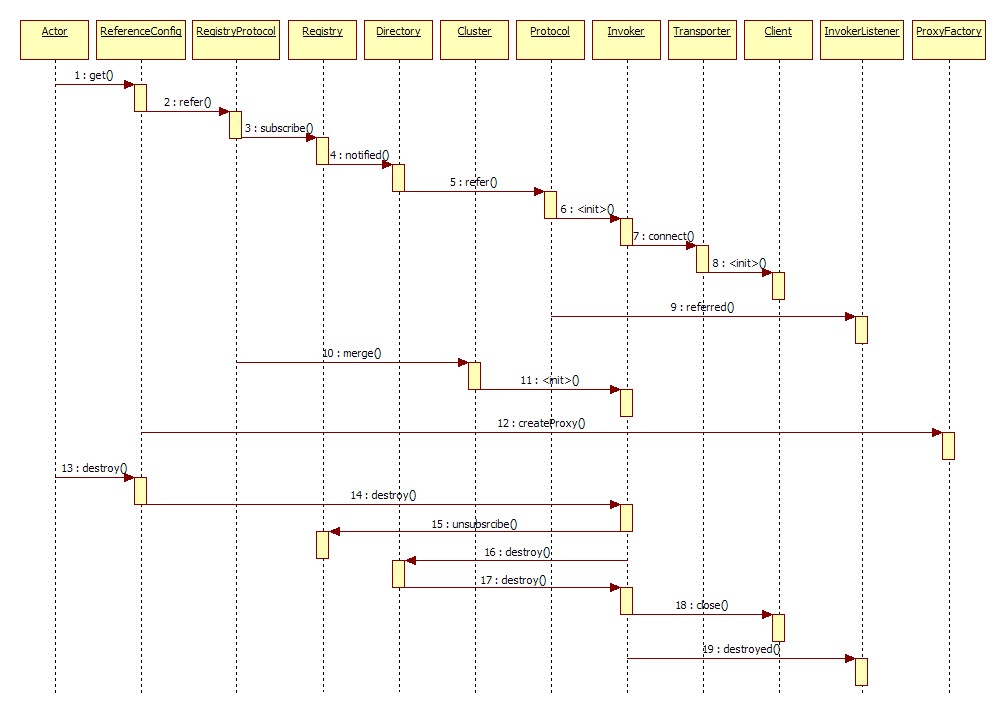Dubbo源码学习--服务是如何引用的
相关文章:
ReferenceBean
跟服务引用一样,Dubbo的reference配置会被转成ReferenceBean类,ReferenceBean实现了InitializingBean接口,直接看afterPropertiesSet()也就是spring为Bean提供的初始化方法
方法调用顺序afterPropertiesSet() -> getObject() -> get() -> init() -> createProxy()

afterPropertiesSet()
afterPropertiesSet()作用为装载应用信息、注册、模块、监控等配置,然后调用getObject()
public void afterPropertiesSet() throws Exception {
//.....
setApplication(applicationConfig);
//.....
setModule(moduleConfig);
//.....
super.setRegistries(registryConfigs);
//.....
Boolean b = isInit();
if (b == null && getConsumer() != null) {
b = getConsumer().isInit();
}
if (b != null && b.booleanValue()) {
getObject();
}
}
getObject()
getObject() 返回 get() 执行结果
public Object getObject() throws Exception {
return get();
}
get()
get() 如果接口代理类(ref) 为空则调用 init() 生成接口代理类
public synchronized T get() {
if (destroyed){
throw new IllegalStateException("Already destroyed!");
}
if (ref == null) {
init();
}
return ref;
}
init()
init() 根据配置生成Map 然后调用 createProxy() 生成代理类

ref = createProxy(map);
createProxy()
具体作用见注释
private T createProxy(Map<String, String> map) {
//1. 创建临时Url
URL tmpUrl = new URL("temp", "localhost", 0, map);
final boolean isJvmRefer;
// 省略部分代码.....
//2.判断是否暴漏本地服务
if (isJvmRefer) {
URL url = new URL(Constants.LOCAL_PROTOCOL, NetUtils.LOCALHOST, 0, interfaceClass.getName()).addParameters(map);
invoker = refprotocol.refer(interfaceClass, url);
// 省略部分代码.....
} else {
//3.判断用户指定URL,指定的URL可能是对点对直连地址,也可能是注册中心URL
if (url != null && url.length() > 0) {
String[] us = Constants.SEMICOLON_SPLIT_PATTERN.split(url);
if (us != null && us.length > 0) {
for (String u : us) {
URL url = URL.valueOf(u);
if (url.getPath() == null || url.getPath().length() == 0) {
url = url.setPath(interfaceName);
}
if (Constants.REGISTRY_PROTOCOL.equals(url.getProtocol())) {
urls.add(url.addParameterAndEncoded(Constants.REFER_KEY, StringUtils.toQueryString(map)));
} else {
urls.add(ClusterUtils.mergeUrl(url, map));
}
}
}
} else {
//4. 通过注册中心配置拼装URL
List<URL> us = loadRegistries(false);
if (us != null && us.size() > 0) {
for (URL u : us) {
URL monitorUrl = loadMonitor(u);
if (monitorUrl != null) {
map.put(Constants.MONITOR_KEY, URL.encode(monitorUrl.toFullString()));
}
urls.add(u.addParameterAndEncoded(Constants.REFER_KEY, StringUtils.toQueryString(map)));
}
}
if (urls == null || urls.size() == 0) {
throw new IllegalStateException("No such any registry to reference " + interfaceName + " on the consumer " + NetUtils.getLocalHost() + " use dubbo version " + Version.getVersion() + ", please config <dubbo:registry address=\"...\" /> to your spring config.");
}
}
// 5.调用refprotocol.refer()
if (urls.size() == 1) {
invoker = refprotocol.refer(interfaceClass, urls.get(0));
} else {
List<Invoker<?>> invokers = new ArrayList<Invoker<?>>();
URL registryURL = null;
for (URL url : urls) {
invokers.add(refprotocol.refer(interfaceClass, url));
if (Constants.REGISTRY_PROTOCOL.equals(url.getProtocol())) {
registryURL = url; // 用了最后一个registry url
}
}
if (registryURL != null) { // 有 注册中心协议的URL
// 对有注册中心的Cluster 只用 AvailableCluster
URL u = registryURL.addParameter(Constants.CLUSTER_KEY, AvailableCluster.NAME);
invoker = cluster.join(new StaticDirectory(u, invokers));
} else { // 不是 注册中心的URL
invoker = cluster.join(new StaticDirectory(invokers));
}
}
}
// 省略.....
// 6.创建服务代理
return (T) proxyFactory.getProxy(invoker);
}
RegistryProtocol
refprotocol.refer()
refprotocol.refer() 先后经过修饰类 ProtocolFilterWrapper、ProtocolListenerWrapper 最后执行RegistryProtocol
ProtocolFilterWrapper -> ProtocolListenerWrapper
//ProtocolFilterWrapper
public <T> Invoker<T> refer(Class<T> type, URL url) throws RpcException {
if (Constants.REGISTRY_PROTOCOL.equals(url.getProtocol())) {
return protocol.refer(type, url);
}
return buildInvokerChain(protocol.refer(type, url), Constants.REFERENCE_FILTER_KEY, Constants.CONSUMER);
}
//ProtocolListenerWrapper
public <T> Invoker<T> refer(Class<T> type, URL url) throws RpcException {
if (Constants.REGISTRY_PROTOCOL.equals(url.getProtocol())) {
return protocol.refer(type, url);
}
return new ListenerInvokerWrapper<T>(protocol.refer(type, url),
Collections.unmodifiableList(
ExtensionLoader.getExtensionLoader(InvokerListener.class)
.getActivateExtension(url, Constants.INVOKER_LISTENER_KEY)));
}
RegistryProtocol
@SuppressWarnings("unchecked")
public <T> Invoker<T> refer(Class<T> type, URL url) throws RpcException {
// Constants.REGISTRY_KEY: registry
// Constants.DEFAULT_REGISTRY: dubbo
url = url.setProtocol(url.getParameter(Constants.REGISTRY_KEY, Constants.DEFAULT_REGISTRY)).removeParameter(Constants.REGISTRY_KEY);
Registry registry = registryFactory.getRegistry(url);
if (RegistryService.class.equals(type)) {
return proxyFactory.getInvoker((T) registry, type, url);
}
// 配置Group信息
// group="a,b" or group="*"
Map<String, String> qs = StringUtils.parseQueryString(url.getParameterAndDecoded(Constants.REFER_KEY)); // Constants.REFER_KEY:refer
String group = qs.get(Constants.GROUP_KEY);
if (group != null && group.length() > 0 ) {
if ( ( Constants.COMMA_SPLIT_PATTERN.split( group ) ).length > 1
|| "*".equals( group ) ) {
return doRefer( getMergeableCluster(), registry, type, url );
}
}
return doRefer(cluster, registry, type, url);
}
doRefer()
- 调用FailbackRegistry.register() 在注册中心注册消费者subscribeUrl
- 调用FailbackRegistry.subscribe() 订阅注册中心subscribeUrl
private <T> Invoker<T> doRefer(Cluster cluster, Registry registry, Class<T> type, URL url) {
RegistryDirectory<T> directory = new RegistryDirectory<T>(type, url);
directory.setRegistry(registry);
directory.setProtocol(protocol);
// Constants.CONSUMER_PROTOCOL: consumer
URL subscribeUrl = new URL(Constants.CONSUMER_PROTOCOL, NetUtils.getLocalHost(), 0, type.getName(), directory.getUrl().getParameters());
//consumer://10.9.22.12/com.**.ShopService?application=test&check=false&dubbo=2.8.4
//&interface=com.**.ShopService&methods=getList&pid=6168&retries=1&revision=1.0-SNAPSHOT
//&side=consumer&timeout=6000×tamp=1484275807134&version=1.0
if (! Constants.ANY_VALUE.equals(url.getServiceInterface())
&& url.getParameter(Constants.REGISTER_KEY, true)) {
registry.register(subscribeUrl.addParameters(Constants.CATEGORY_KEY, Constants.CONSUMERS_CATEGORY,
Constants.CHECK_KEY, String.valueOf(false)));
}
directory.subscribe(subscribeUrl.addParameter(Constants.CATEGORY_KEY,
Constants.PROVIDERS_CATEGORY
+ "," + Constants.CONFIGURATORS_CATEGORY
+ "," + Constants.ROUTERS_CATEGORY));
return cluster.join(directory);
}
引用服务时序



